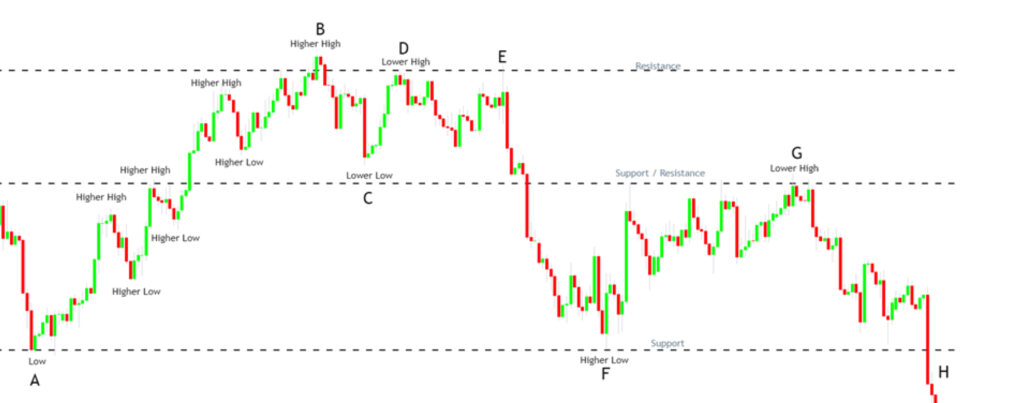
In this article, we will explore a detailed technical analysis of a price chart, focusing on key points where significant price movements occur. By examining higher highs, lower lows, support and resistance levels, and candlestick patterns, we gain valuable insights into market trends and potential reversals. Understanding these elements helps traders make informed decisions, manage risk, and capitalize on price action. The analysis covers critical turning points in the market, providing tips for traders on how to interpret and respond to these movements effectively.

Chart analysis
One of the most efficient ways to explain market structure is to offer an analysis of a chart and explain how prices react at key points.
Point A – Low
- Analysis: At point A, the price reaches a significant low, suggesting a potential reversal point. This is often where the market finds support, meaning buyers are starting to come in at this level. A new trend may emerge here.
- Trader’s tips:
- Look for confirmation of the reversal. A bullish candlestick pattern (such as a hammer) at this level could confirm that buyers are stepping in.
- Consider entering a long position if there’s additional confirmation, such as a bounce from this level with rising volume.
- Place a stop-loss below the recent low to manage risk in case the price breaks down further.
Point B – Consecutive Higher Highs
- Analysis: As soon as the price broke through the second higher high on the chart, it confirmed the change in trend and it has turned bullish. The price has is creating constant higher highs, and higher lows up until Point B. Price has been trending upwards for some time, so it might reach a point where traders would be more willing to capitalize on their gains.
- Trader’s tips:
- Traders should watch for breakouts above resistance levels. If the breakout is accompanied by increased volume, it’s a stronger signal of continued bullish momentum.
- Consider adding to long positions or riding the trend upward.
- Set trailing stops to lock in profits as the price continues to rise.
- Keep an eye on market sentiment; any signs of weakening momentum (e.g., declining volume, extended RSI) could signal a potential reversal.
Point C – Lower Low
- Analysis: The price makes a lower low, which is a first sign that the market sentiment may start to change and to start being a bit cautious. Lower low shows that sellers are able to push the price more aggressively than before, but not enough to warrant a belief that there has been a change in trend. This is why buyers still step in and push the price upwards again preventing the price from falling further.
- Trader’s tips:
- Traders should be cautious here. The formation of a lower low signals that the selling strength is increasing, and the market could be setting up for a potential trend reversal.
- Traders can look for support levels forming at this lower low, which can act as a good point to place stop-losses to manage risk.
- Use technical indicators like RSI or MACD to ensure there’s no divergence indicating weakening momentum.
Point D – Lower High
- Analysis: At point D, the price fails to make a new higher high and instead forms a lower high, which is another warning sign of potential trend reversal or weakness in the uptrend.
- Trader’s tips:
- This is a good area to tighten stop-losses or consider taking profits on long positions.
- Look for bearish patterns such as double tops or head and shoulders. If confirmed, these are strong signals of an impending downtrend.
- A volume decrease during the rise to this lower high could also signal weakening bullish momentum.
Point E – Resistance
- Analysis: Point E shows the price testing the previous price point of D and it has formed a key resistance level and fails to break through. This confirms the strength of the resistance and suggests a potential shift from bullish to bearish sentiment.
- Trader’s tips:
- If the price cannot break through resistance after several attempts, it’s a signal that buyers lack the strength to push higher. Traders can look to short at resistance with a stop-loss slightly above it.
- Watch for bearish reversal candlestick patterns, such as shooting stars or engulfing patterns, which provide further confirmation.
- Traders may also use momentum indicators (e.g., RSI) to identify if the market is overbought and due for a reversal.
Point F – Support / Lower Low
- Analysis: At point F, the price holds above the previous support level that was formed at Point A. This confirms the strength of this key support level and buyers step in to push the price higher.
- Trader’s tips:
- Look for reversal candles at previous key support levels to potential enter new longs.
Point G – Lower High
- Analysis: The price forms a lower high at point G, confirming the continuation of the bearish trend. A series of lower highs and lower lows indicate that sellers are still in control of the market. The previous level that acted as support for Point C, is now acting as Resistance.
- Trader’s tips:
- Traders should remain cautious about any rallies in a downtrend. Look for opportunities to sell the rally or add to short positions.
- Watch for confirmation of the failed attempt to break through the resistance level with candlestick patterns or indicators.
- Be aware of support levels below to set profit targets. If the price breaks below a previous low, the downtrend will likely continue.
Point H – Breakdown
- Analysis: At point H, the price breaks through key support levels and shows a sharp decline, signaling a strong continuation of the bearish trend.
- Trader’s tips:
- A breakdown below a major support zone is typically accompanied by increased selling pressure. Traders should consider entering short positions or scaling into existing ones.
- Be cautious of potential false breakouts; ensure the breakdown is confirmed by higher volume or a retest of the previous support level as new resistance.
- If the breakdown happens with high momentum, use momentum indicators like the RSI to avoid entering at oversold levels.
- Be aware of next support levels or zones where the market could pause or reverse.
General things to pay attention
- Volume: Always pay attention to volume when key levels are tested. Breakouts and breakdowns with higher-than-average volume are more likely to be genuine.
- Confirmation: Don’t rush into trades based on a single candle or pattern. Wait for confirmation, especially when key levels like support or resistance are being tested.
- Indicators: Complement candlestick analysis with other technical indicators such as the Relative Strength Index (RSI), Moving Averages, or Bollinger Bands to ensure you have a broader understanding of market sentiment.
- Risk Management: Always set stop-losses based on nearby support/resistance levels and never risk more than you can afford to lose on a trade.
- More like this


